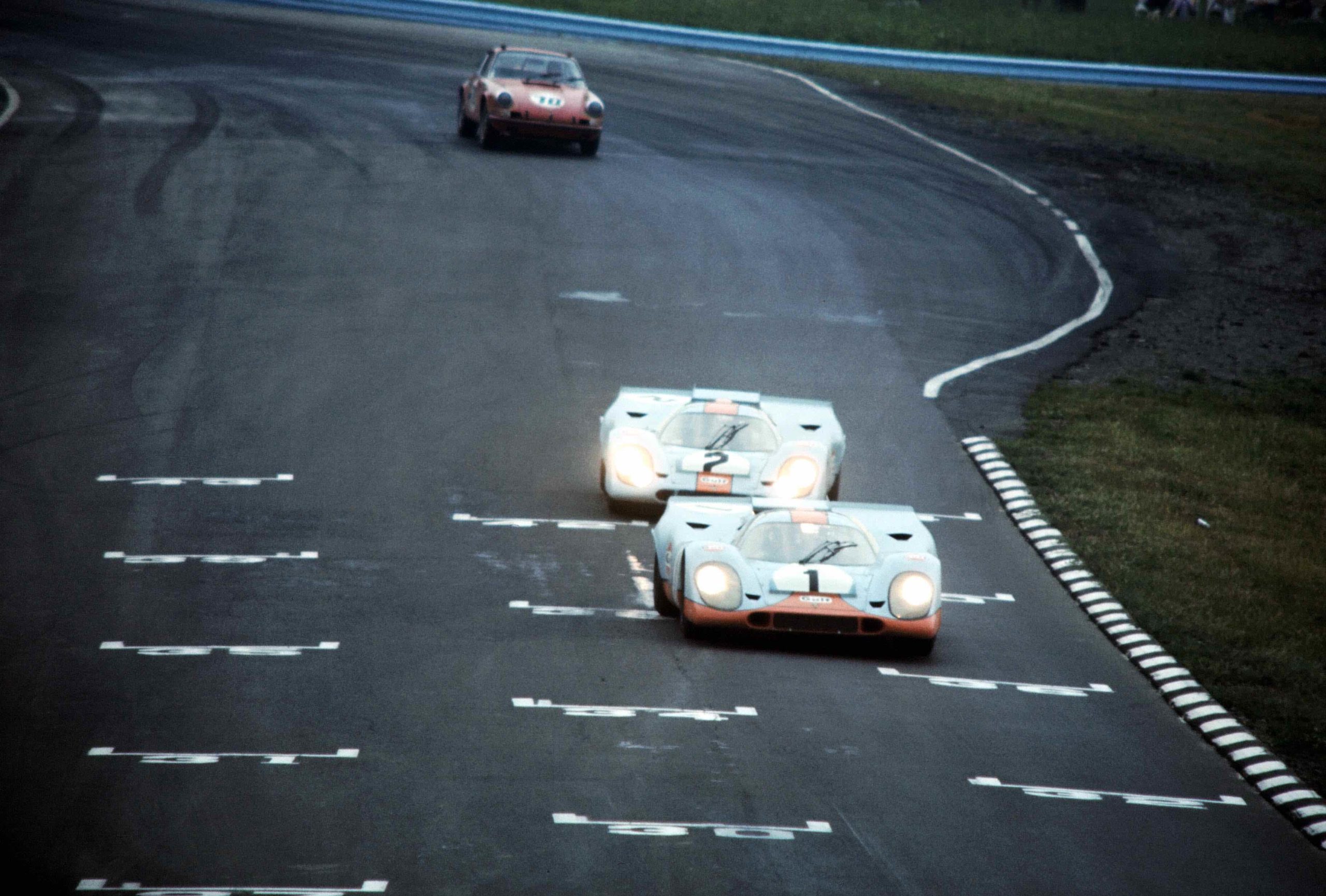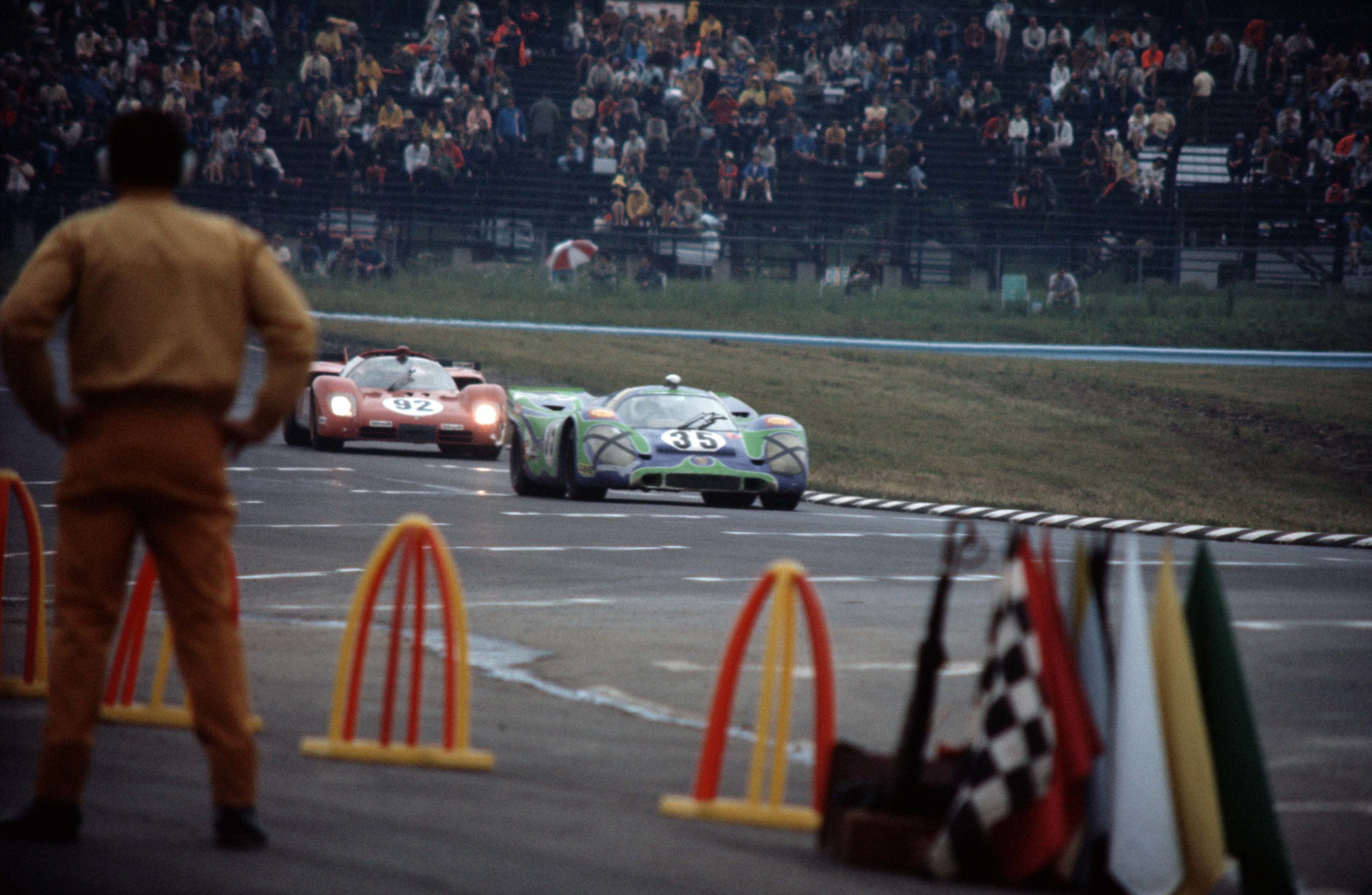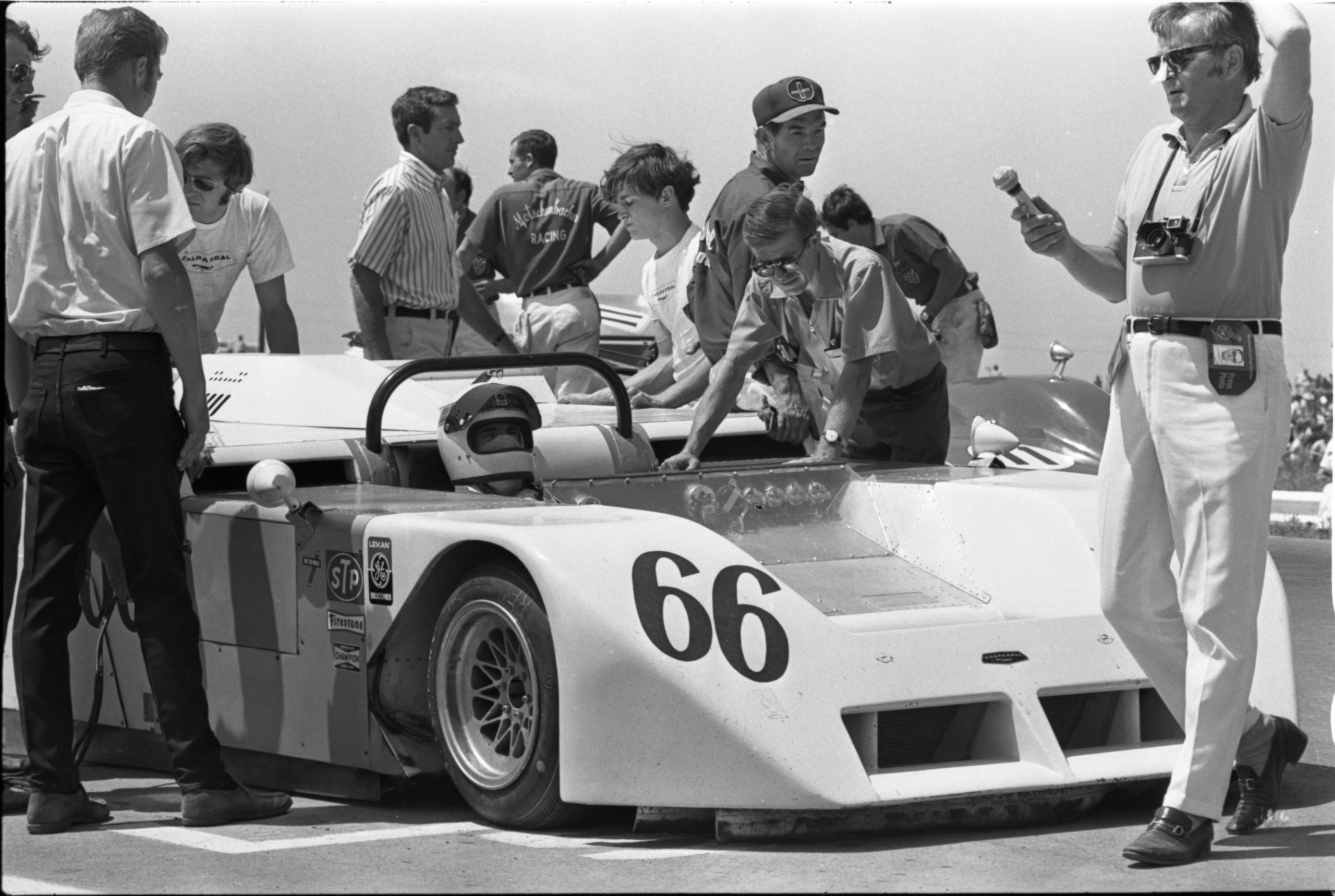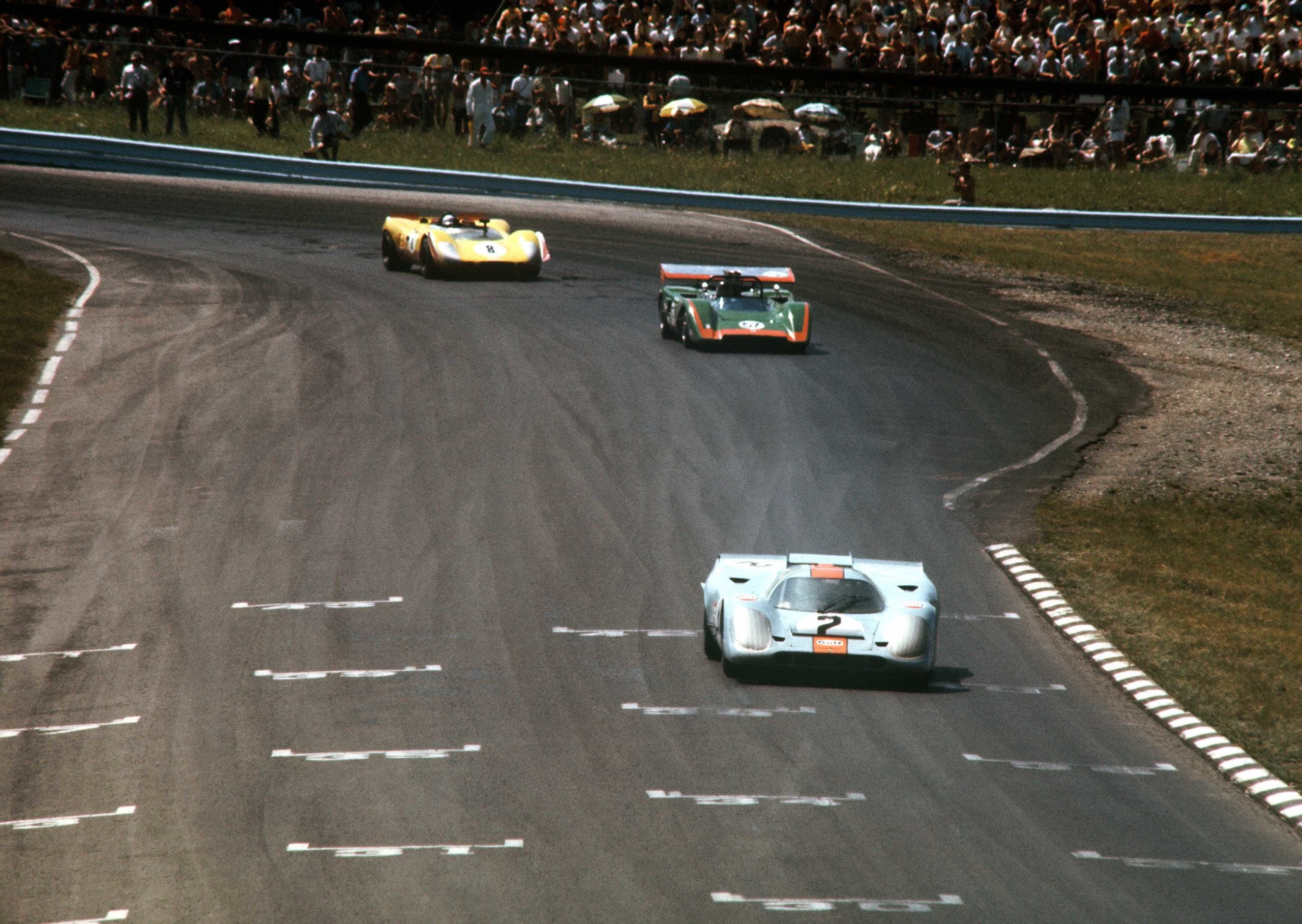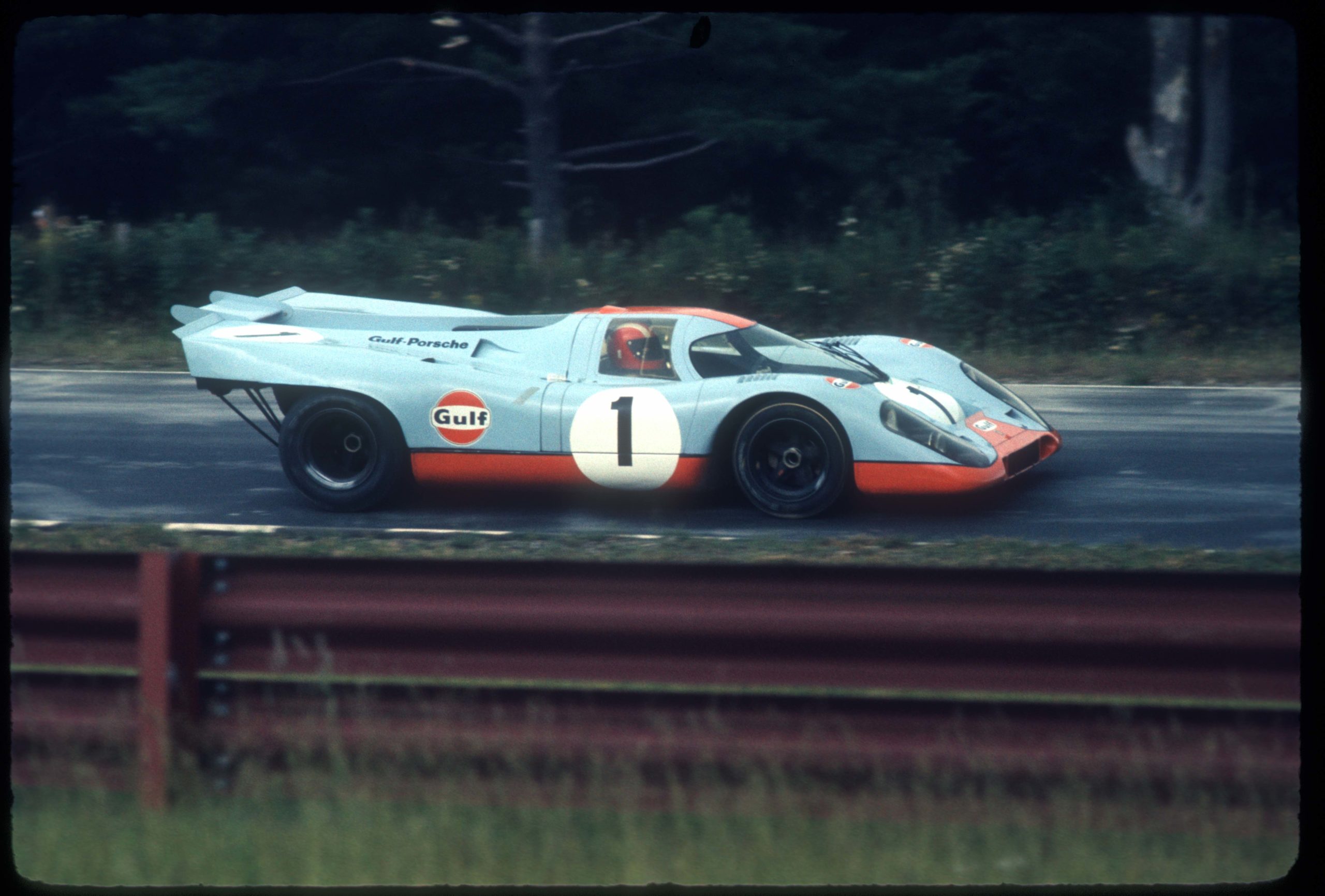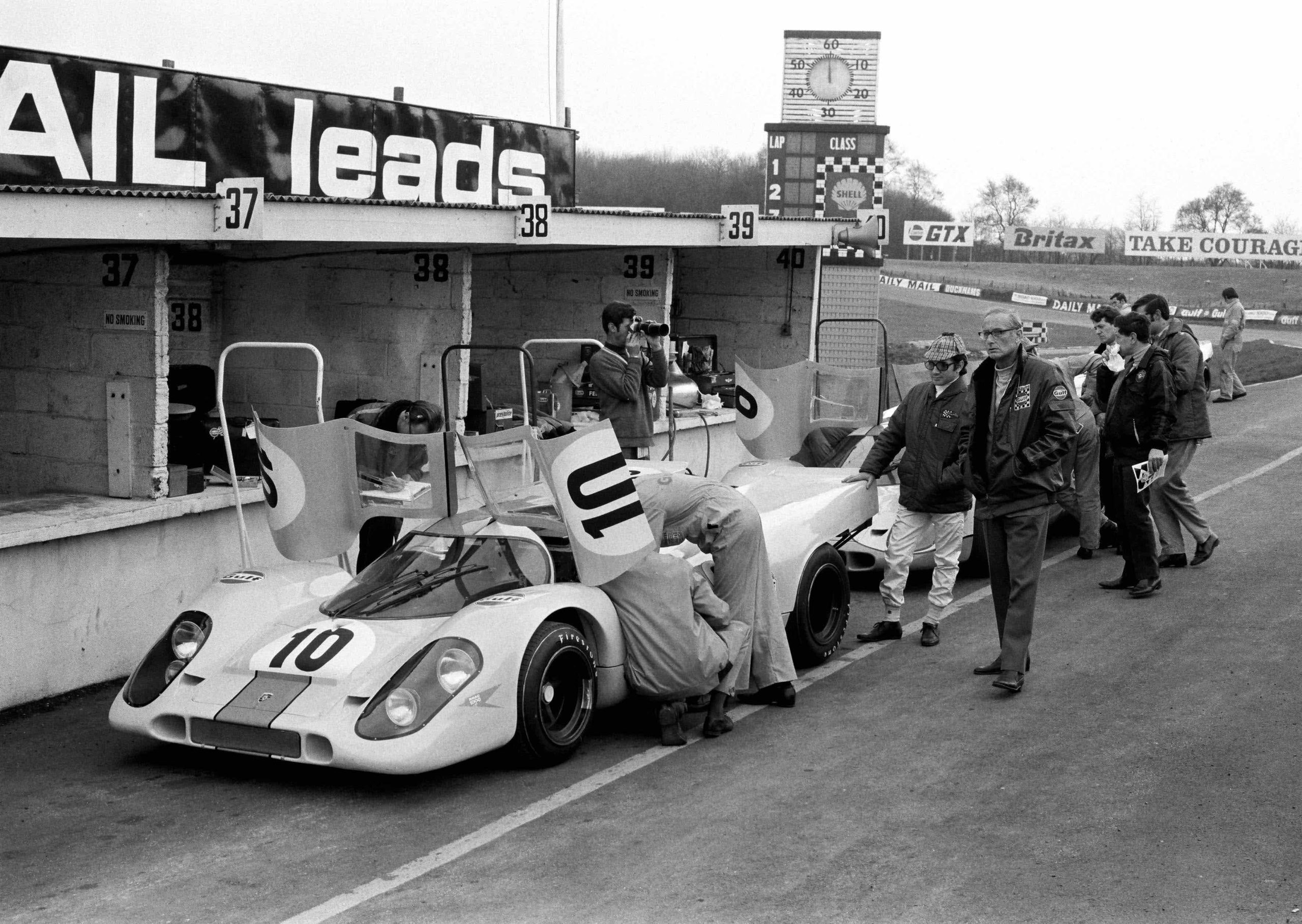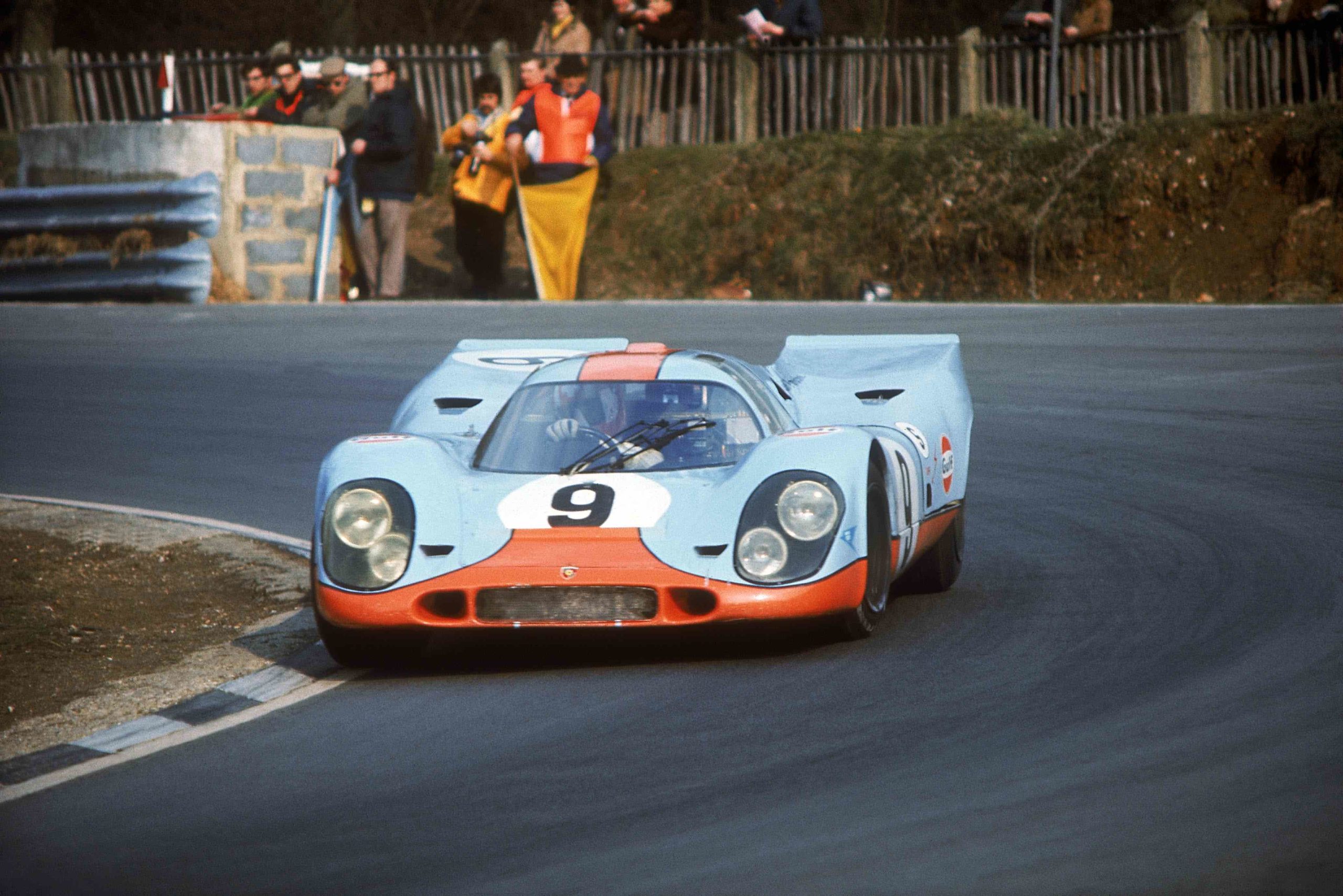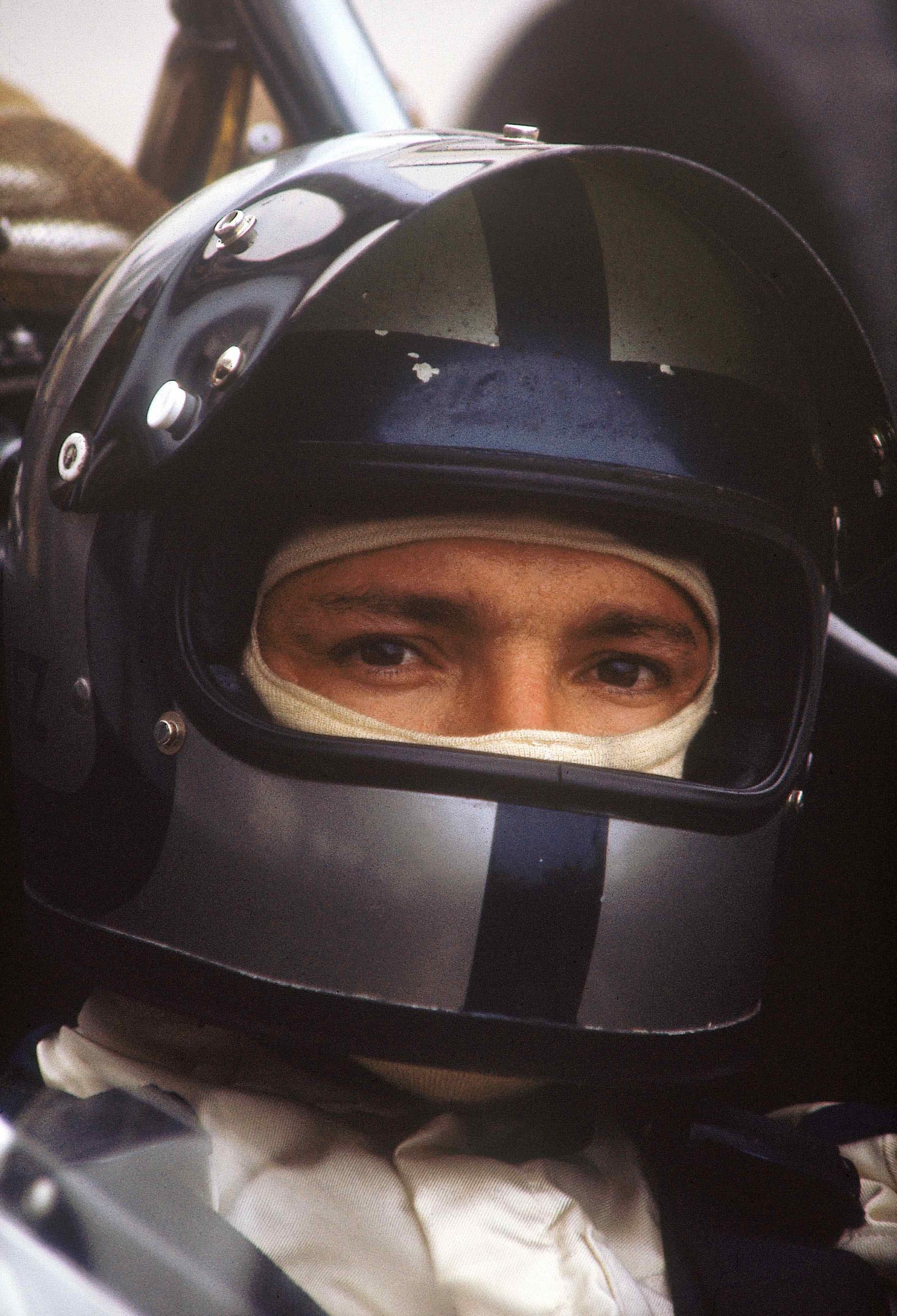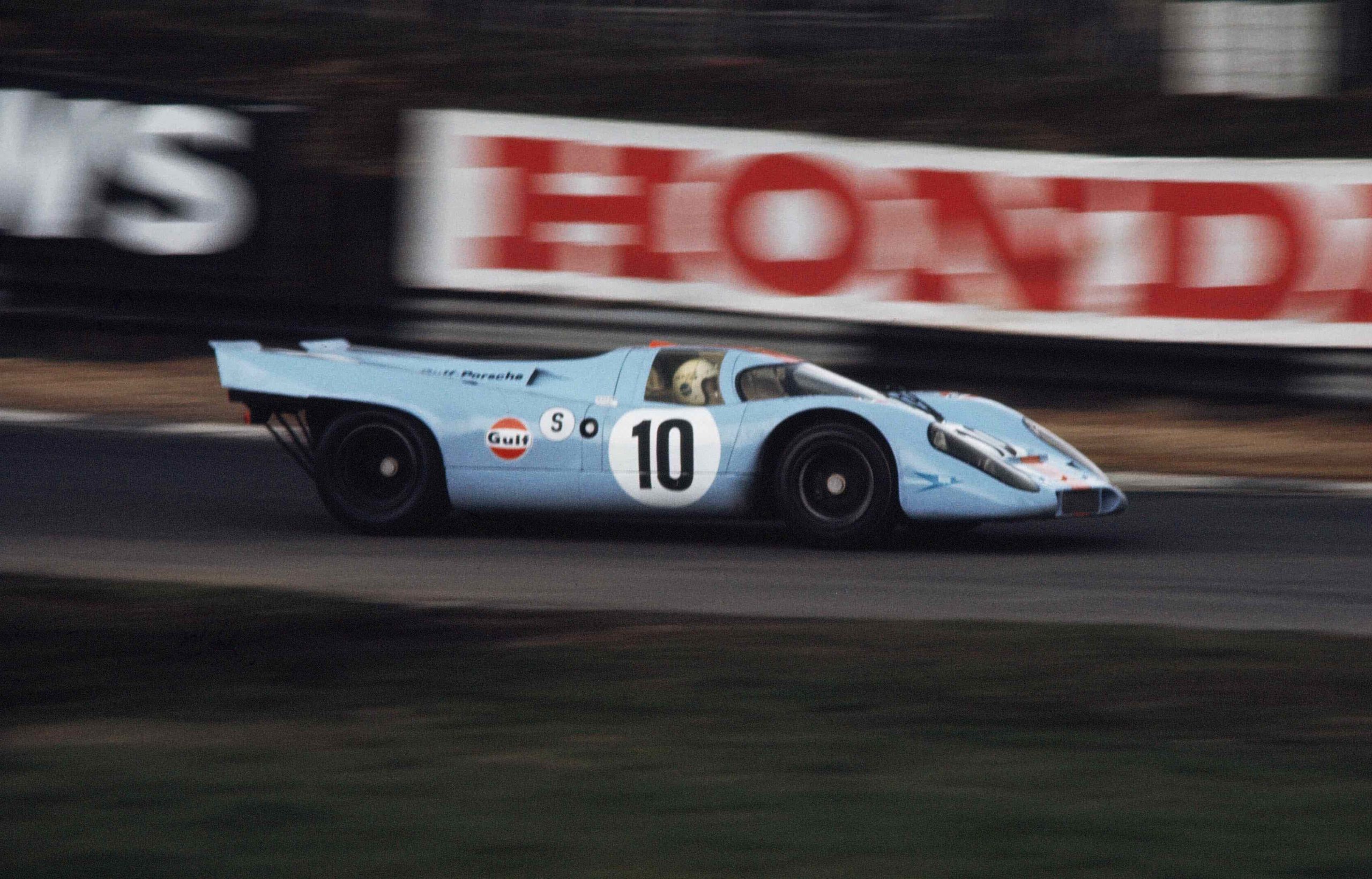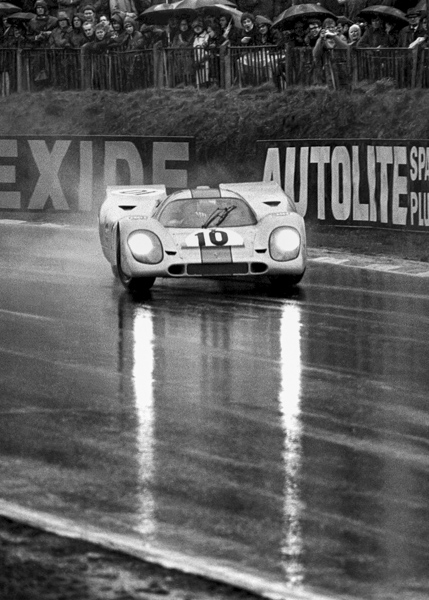July 11th and 12th, 1970 saw the World Sportscar Championship return for the third race of the year in the United States. Watkins Glen would host the Six Hour endurance race on Saturday and the Can-Am race on Sunday making it a double-header for some of the teams and drivers.
Porsche came into the weekend on a roll, having already clinched the Manufacturer’s Championship and having recorded their first overall victory at Le Mans. Ferrari had a poor race at Le Mans and hadn’t been close to a victory since Monza in late April. John Wyer’s JWAE/Gulf-Porsche team had a truly disastrous race at Le Mans and were looking to regain the dominant form they had shown most of the season.
Early on in practice, Jo Siffert was very unhappy with his Gulf 917 according to Ermanno Cuoghi in his book, Racing Mechanic: “Siffert was not happy with his car, it was just no good compared to Pedro’s. So we put Pedro’s car in one flat concrete bay and take all the suspension geometry readings off that car. Then we push Siffert’s car on the same spot, check everything out – especially bump and rebound settings- and it was quite a long way out. So we put Siffert’s car in exactly the same trim and Siffert was very happy with that car.” In Ian Wagstaff’s book, Porsche 917 – Owner’s Workshop Manual, mechanic Alan Hearn confirmed that bump steer (and toe-in) was critical on the 917 and something the JWAE mechanics worked on very carefully when setting up the cars in the workshop at Slough. At Watkins Glen, the team experimented with a revised rear fender shape to better accommodate 17-inch rear wheels. They also used special 10.5-inch front wheels to work better with revisions to the front suspension with reduced off-set. Although the track surface was new, it was breaking up in places so the team chose Firestone intermediate tires.
Jo Siffert in 917-014, Watkins Glen Six Hour Race. Photo: Porsche Archive
Ultimately, Siffert took pole position for the Six Hour, just three-tenths of a second faster than one Mario Andretti in a Ferrari 512S and Pedro Rodriguez in the other Gulf 917. Jacky Ickx and Peter Schetty were fourth fastest in the other factory-entered Ferrari 512S, followed by three more Porsche 917s. Larrousse and van Lennep were fifth fastest in the Martini entry (painted in psychedelic ‘Hippie’ colors). Sixth and seventh were the two Porsche-Salzburg 917s, Richard Attwood driving with Kurt Ahrens and Vic Elford paired with Denis Hulme. Jo Bonnier’s Lola T70 was eighth fastest with co-driver Reine Wisell.
After the rolling start which was standard at the races in America, there was quite a tussle at the first corner as Siffert and Mario Andretti touched, Siffert nearly spinning. Andretti led at the end of the first lap in the Ferrari, but Siffert passed for the lead on lap three. Siffert then led the race with Rodriguez closing in and passing just before the first fuel stop. There was light rain at the one hour mark and Siffert apparently had a misfire due to the rev limiter re-setting itself so it was disconnected at the first fuel stop.
Early in the race, Rodriguez had been flashing his lights to warn back-markers of his approach, but accidentally switched off a fuel pump (an easy mistake to make according to Alan Hearn, given the proximity of the fuel pump switches to the light switch). Realizing his mistake, Pedro then got back up to full speed and managed to claw his way back to the front. He actually got into the lead by lap 35, perhaps roused by his own error. He lost the lead to Siffert on lap 50 but gained it again on lap 53.
Rodriguez hounding Siffert in the Gulf-Porsche 917s. Photo: Porsche Archive
Rodriguez and Siffert then had a coming together around lap 100. This one was quite a bit more substantial than the touch at Spa earlier in the year. Pedro was approaching to put Jo a lap down. Siffert was not inclined to give way and when Pedro tried to swing by, Siffert clouted Rodriguez’s car, leaving a large tire mark on Chassis 016’s driver side door. In the film A Year To Remember, John Wyer stated that Siffert was trying to pass slower traffic and may not have seen Rodriguez coming up behind him. Perhaps Wyer was making an excuse as it seemed the simmering rivalry was now on full boil and the wheel banging and paint-swapping caused a flat tire for Siffert.
At the pit stop for a driver change, Ermanno Cuoghi and the Gulf mechanics made a quick repair to the damaged door on Rodriguez’s car. During the middle part of the race, Siffert’s co-driver, Brian Redman regained the lead and in a see-saw battle, Redman and Siffert then led from lap 105 to 160. However, when Rodriguez got back in the car, he put on his usual charge, as the situation demanded and took the lead on lap 161.
The wheel-banging incident may ultimately have cost Siffert and Redman a chance to win as their oil tank developed a leak after Redman had passed Kinnunen for the lead on lap 204. The oil tank was located on the left side of the car where the collision occurred. The tank repair put Siffert too far behind at a critical part of the race. Pedro took the lead from the Gulf sister car again on lap 211 and held it until the end. After 308 laps, Rodriguez was in first place by 44 seconds over the sister Gulf 917. Although Kinnunen only drove 51 laps to Rodriguez’s 257, his average lap time was recorded as four-tenths faster than Rodriguez in the JWAE race datasheet. Redman’s average lap time was only four-tenths slower than Siffert and given the variables of weather and traffic in a six-hour race, it shows that the nominal #2 drivers were highly capable behind the wheel.
Ignazio Giunti, Ferrari 512S versus Gijs van Lennep in the Martini-entered Porsche 917. Photo: Porsche Archive
Andretti and Ignazio Giunti held on to finish third, three laps down in their Ferrari 512. Jacky Ickx and Peter Schetty were fifth for the Ferrari factory. The Ferraris were hampered during the race by problems with their fuel systems. The Porsche Salzburg 917s finished in fourth and sixth places, Attwood ahead of Elford. This was the third of three wins in 1970 for 917 Chassis 016, which had won at Brands Hatch and Monza in April. The Watkins Glen Six Hour race was the closest head-to-head battle of the 1970 season between the Gulf teammates.
Jackie Stewart in the Chaparral 2J, Chris Economaki in front of the car. Photo: Kathie J. Meredith Collection/IMRRC
On Sunday, the Can-Am race was notable on a number of fronts. At the top of the list was the presence of reigning F1 World Champion, Jackie Stewart, driving for Jim Hall in the brand new and radical Chaparral 2J. This very early attempt at ground effect used an auxiliary two-stroke snowmobile motor to drive two fans at the box-shaped rear of the car. The fans sucked the air from under the car and kept it glued to the road. Lexan ‘skirts’ provided a seal under the car to maintain the suction effect. Problems with debris from areas of the track breaking up would hamper the auxiliary motor and fan drive during the event which started with practice on Wednesday. Stewart also admitted to having a learning curve with left-foot braking in the two-pedal, automatic transmission Chaparral. As far as the handling was concerned, Stewart enthused: “Adhesion is second to none, and is like comparing the road-holding of a touring car to that of a Formula One machine.”
The Gulf team entered their three 917 coupes in the Can-Am race. Although lacking the maximum power of the big-block Chevrolet-powered cars, the endurance racers performed quite well. Participation allowed the drivers to compete for significant prize money and Siffert would put on a great driving display. The final results were even more impressive considering that Siffert and the other Group 5 runners had to pit for fuel while the Group 7 Can-Am cars could go the whole distance without stopping.
A big crowd, stated at 70,000, saw Denis Hulme sit on the pole alongside Dan Gurney in the other McLaren M8D. This being the third race of the Can-Am season, the team were still adjusting to life without the founder, Bruce McLaren, who had been killed in testing in April. On Saturday evening, Hulme’s car was changed down to a 430 cubic inch Chevy from the regular 465 due to concerns about cooling. Stewart was third on the grid in the Chaparral with Peter Revson fourth in the Lola T220. Gurney and Revson stayed with the larger Chevy engines for the race. Mario Andretti was fifth fastest in his 5-liter Ferrari 512S. Lothar Motschenbacher was sixth fastest in an M8B with Jacky Ickx seventh for Ferrari. With all the endurance cars entered, the field for the Can-Am was an Indy-size 33 cars.
At the start of the race, Revson passed Stewart for third and held it until lap four when Stewart vacuumed his way back to first place of those chasing the McLarens. He was able to stay in close touch with Dan Gurney until lap 14 when the Chaparral came in for a long pit stop due to vapor lock. After seven further exploratory laps, the car was retired with near complete loss of brakes. Stewart did set fastest lap at 125.86 mph average speed, winning a $1000 bonus. Revson held third place until his oil pump drive belt failed. Gurney maintained second position, even with a black flag stop for passing under the yellow, but then had two lengthy stops with the engine overheating. Dan would soldier on to finish ninth.
Pedro Rodriguez, 917-016 in the 1970 Watkins Glen Can-Am. Photo: Porsche Archive
Pedro Rodriguez started 10th and moved up steadily, eventually running in fourth place. However, he missed a gear and dropped out with a blown engine on lap 32. It was the only time that Rodriguez fell victim to the 917’s well-known Achilles’ heel. In The Certain Sound, John Wyer recounts talking with Bob Corn of Ford Engineering Research regarding the problem of 917 over-revs wrecking the valve train. Corn advised that given the relevant data, a valve spring could be designed that would give a greater margin of safety. JW states that he reported this to Porsche’s Ferdinand Piech who “brushed it aside. It was the typical Porsche reaction to NIH (not invented here).” This doesn’t speak to the issue of the rev limiter itself not being able to act quickly enough.
Siffert had two spins while avoiding slower cars but at one point he was within 10 seconds of Hulme and “in some danger of winning the race” as John Wyer said before being balked by slower traffic. As Wyer also remarked in A Year To Remember, Siffert had to “motor over half of New York State” in one incident! Late in the race Hulme was slower than normal due to high coolant temperature and problems with the track surface that limited the power application for the big-block cars. Track debris was partially blocking the cooling system in his McLaren. Hulme was also suffering from still-painful burns on his hands from an incident at the Indy 500. Given the heat, his hands and difficult track conditions, he was quoted as saying the race was “the toughest I’ve ever run.” At the finish, Siffert in 917 Chassis 014 was only 28 seconds behind the McLaren. John Wyer called it one of the best races of Siffert’s life and since Jo (ever the wheeler-dealer) won more money for finishing second than Pedro had for winning the day before, he was very happy. Siffert won $9000 for second place plus the $1000 BOAC ‘Man of the Race’ bonus.
Jo Siffert in the Gulf-Porsche 917. Photo: Kenneth French Collection/IMRRC
It should be noted that on a rough day for the regular Can-Am campaigners, the Porsche-Salzburg 917s, sponsored by Porsche-Audi, finished third and fourth (Attwood ahead of Elford). Since 917 Chassis 015 was on hand at Watkins Glen as the Gulf T car, it could be assigned to Brian Redman for the Can-Am race. Redman finished seventh after being delayed by a right rear puncture on the 60th lap. 015 wore race number 6 with the orange greenhouse livery. In fact, the Group 5 endurance racing cars finished in second through seventh place including Mario Andretti, fifth for Ferrari and Gijs van Lennep, sixth in the Martini 917.
Regarding the Chaparral 2J ‘sucker’ car, author Karl Ludvigsen noted in Excellence Was Expected that Porsche’s Dr. Bott took the occasion to remark that Porsche had considered reversing the direction of the 917’s cooling fan to create the same effect. Porsche rejected the idea due to concerns about sucking dirt and debris into the engine area, as well as the problem of bumps on track changing the suction effect. It was also thought not to have any applicability to Porsche’s road cars. Since racing came under the general category of Research & Development, this was always a significant consideration for Porsche.
Watkins Glen was the 16th consecutive Can-Am victory for McLaren and they were getting ready to debut the M8E a bit later in the 1970 season. The JWAE-Gulf team would go on to win the final race of the World Sportscar Championship in Austria, making it seven wins for Gulf-Porsches in the ten race series for 1970.
Special thanks to Jenny Ambrose of the IMRRC for assistance with research materials and photos for this article.
April 12, 1970, was the date for one of the most famous endurance sports car races. The race was run partly in heavy rain and became a showcase for one of the great car and driver combinations in motorsport history. Mexican driver Pedro Rodriguez and his Gulf-Porsche 917 thoroughly defeated the opposition in one the best drives of his storied career.
Pedro Rodriguez with JWAE Team Manager, David Yorke, during practice for the BOAC 1000 Km at Brands Hatch in 1970. Photo: Porsche Archives
In contrast to the race, the weather was dry for practice and qualifying. Chris Amon put his Ferrari 512 on the pole, with Jacky Ickx second fastest, showing that Ferrari was competitive on pace after having won the previous race at Sebring. For the Gulf 917 team of Rodriguez and Leo Kinnunen, there was a gearbox problem in practice. The team elected to move the car to the grass area ahead of the pits for more room to work (the pits being congested and the paddock too far away). The problem was with the linkage and connection where it went into the gearbox. Pictures show the team around the car with the right side transmission cooling duct removed. Rodriguez ultimately qualified seventh with Jo Siffert and Brian Redman fifth in the other Gulf 917. Vic Elford was third in another 917 for Porsche-Salzburg. The 3-liter Matra MS 650s were fourth and sixth in qualifying. The top seven cars were all within 1.4 seconds of each other on lap times. The rather short, twisty Kent circuit was not ideally suited to the 917, a car designed for high-speed tracks like Monza, Spa, and Le Mans. All the cars in the race wore special decals on the front fenders; a blue BOAC 1000 KM logo.
Jo Siffert in his Gulf-Porsche 917 during practice. Photo: Porsche Archive
Readers may notice that the Gulf 917s look a little odd in some photos from the race. The reason is that for part of the race, they ran on wheels that were only 9.5 inches wide in front, 12 inches at the rear. Firestone had recommended the narrow wheel approach to the Gulf team as it would make the cars easier to control in heavy rain. The Firestone wet tires were also thought to perform better than the Goodyears on the Salzburg Porsches, giving the Gulf team an additional edge. Ferrari ran on Firestone, so no difference there. JWAE Chief Engineer, John Horsman, noted that on lap 154, the team elected to change to intermediate versus full wet tires, the intermediates being the normal 10.5 and 15-inch widths.
Despite the gloom, a good crowd of 20,000 came out to see the biggest sports car race of the year in England. A cold (47 Fahrenheit/8 Celsius), steady rain fell in the hours before the race and right through the start. There was some debate among the officials about whether to start the race but Clerk of the Course Nick Syrett was determined to go ahead. An equally determined Vic Elford passed Chris Amon and Jacky Ickx in their Ferraris on the first lap, hoping for a few laps clear of the spray from other cars. Barrie Smith’s Lola T70 spun and crashed at the end of the first lap, at the start/finishing line. Smith was forced to start without regular rain tires on the rear because Goodyear ran short of tires in the needed size. It is possible that Pedro Rodriguez passed another car in the yellow flag area but also it is likely he was unable to see the yellow flag due to the spray. Most of the drivers agreed it was possible to have missed the flag the way it was initially displayed.
Porsche Archive candid of Pedro Rodriguez.
Syrett took over the waiving of the yellow and became upset with Rodriguez’s speed and proximity on the next two laps as the marshals attempted to move Smith’s car safely off track. He then elected to show Pedro the black flag, which Rodriguez ignored for two additional laps. Syrett then advised John Wyer that Pedro would be disqualified if he didn’t come into the pits. Pedro finally came into the pits (on lap six) on the signal from his team. In The Autobiography of 917-023, author Ian Wagstaff quoted Rodriguez’s lead mechanic, Alan Hearn, on what happened next: “Pedro then came tearing down the pit road and I was assigned to open the driver’s door when he stopped. Syrett was hovering right behind me. As soon as I opened the door I could see from his blazing eyes that Pedro was not happy. Straight away, Nick dived in the cockpit with his head well down and proceeded to have a right go at him for dangerous driving, a real tongue lashing. Pedro just kept staring straight ahead, not looking at Syrett until he was finished, which took about 20 to 30 seconds. I could see he was fuming. All this time the engine was running. As Syrett stepped away from the car I quickly shut the door. Pedro revved like mad, spun the rear wheels and shot off down the pit road at a very rapid rate. We were lucky we didn’t get our toes taken off…..”
Syrett was an imposing figure, standing over six feet tall and well over 200 pounds. All the witnesses agreed that Pedro sat impassively, but with a building fury, not making eye contact while Nick gave his finger-wagging lecture. Pedro later told John Wyer that he did not see the yellow flag and did not feel he was driving unsafely. After the lecture, Pedro rejoined the race almost a full lap behind the leaders. Syrett had unknowingly set the stage for one of the all-time great drives but he also told Wagstaff that the “telling off” continued after the race on the lap of honor!
Vic Elford led the early laps until he was caught and passed by another acknowledged rain-master, Jacky Ickx. However, Ickx had to pit on lap eight with wiper problems. Rodriguez was already on a furious charge through the field and was up to third place on lap 15. Amon’s Ferrari was running in second place and Chris forced his way past Elford on lap 16 to lead briefly. Pedro passed Elford on lap 18 and set off after the Ferrari. On lap 20, Pedro charged out of Clearways, pulling alongside at start/finish and splashed by Amon in the Paddock Hill bend for the lead.
Siffert was delayed on lap three by a puncture of the left rear tire. Jo and Brian eventually held station, alternating between second and third place until Redman crashed on lap 177. The accident happened at Westfield bend as Brian was pushed off the road by Amon’s Ferrari. Because the car hit a bank while traveling backward, the rear bodywork was pushed over the top of the car, trapping Redman inside. The marshals eventually extricated the driver who made his way back to the pits, wet and muddy, from the farthest point on the track. Brian had expressed some concerns about the safety aspect of the 917. He related the story of this accident and subsequent discussion with Porsche’s Dr. Bott to the writer in 2009:
“I was lying second (when) I got tapped by Chris Amon in the Ferrari 512 and it spun me. I went into a banking and I couldn’t get out because the tail came up over the roof. Anyway, I’d been complaining to Porsche engineering, to Herr Bott in particular, about why did Porsche build these aluminum space frame chassis when everybody else had monocoques or semi-monocoques. The Kurt Ahrens car had broken in half across the cockpit, the John Woolfe car had broken in half across the cockpit. So, when I got back to the pits, it’s raining, I’m muddy, and Herr Bott says: ‘Brian, are you okay?’ I said ‘yes, thank you, Herr Bott.’ He then said, ‘Now you see the 917 is a very good car to have a crash in!’
The possible consequences of a fire in this type of crash may have been lost on the soggy Dr. Bott at that moment. Brian’s references are to the fatal crash of John Woolfe at Le Mans in 1969 and Kurt Ahrens’ crash at the Volkswagen test track just six days before the Brands Hatch race.
Leo Kinnunen in 917-016 during practice. Photo: Porsche Archive
By lap 50, Rodriguez’s lead was over a minute and a half on the field. By the two-hour mark, he was able to put Elford a lap down for the first time. Both Elford and Rodriguez had spins of their own in the appalling conditions but were able to get back on track. Approaching three and a half hours, Rodriguez stopped for the mandatory driver change, Kinnunen taking over for 38 laps. After about four hours, the rain eased off and the track began to dry some. Like Rodriguez, second-place driver Elford drove nearly six hours out of a 6 hour, 45-minute race. Elford’s co-driver, Denny Hulme, was never a fan of driving in the wet and he gladly deferred to the ex-rally man. For the record, the winning car (917 Chassis 016) covered the 235 laps in 6 hours, 45 minutes, 29.6 seconds. In all, Rodriguez lapped the field five times. John Horsman noted in his book that the fans delighted in Pedro’s masterful work, staying to the end of the race despite the miserable conditions.
Pedro Rodriguez sliding through the wet and gloom of April 12th, 1970. Photo: This image was graciously provided by the Mike Hayward collection, a specialist library of classic British motorsport photographs and is available for purchase as a print here: www.mikehaywardcollection.com.
Many superlatives have been offered over the years about Rodriguez’s drive. David Hobbs, who watched from the Gulf team pits was on hand as a reserve driver in case Brian Redman didn’t make it back from the Le Mans test weekend in time for the race. Hobbs recalled: “There was never anything similar to Pedro that day in Brands Hatch; it was the greatest performance I’ve seen.”
Brian Redman said: “Pedro, no doubt, became someone different after the incident in Brands Hatch. From then on, his stature in the eyes of others grew impressively. We all knew how good he was, but that day, the whole world took notice.”
Vic Elford wrote: “Both Jacky Ickx and I were acknowledged wet-weather drivers, but neither of us had an answer to Pedro that day. He simply trounced everyone.”
From Richard Attwood: “I would challenge anyone to drive a car as fast as Pedro did that day. Jim Clark, had he been alive, or any other you could name, in fact, nobody could have equaled Pedro that day.”
In 2013, Alain de Cadenet, who drove a Porsche 908 in the race, wrote: “No racer, before or since, could fail to have felt proud of Pedro that day at Brands.”
John Horsman in 2014 said simply: “It was the right car on the right tires with the right driver.”
Ian Wagstaff quoted Rodriguez’s companion Glenda (Fox) Foreman: “I think Pedro was almost in awe of himself that day…”
Interestingly, the Gulf Team headmaster, John Wyer, thought that Pedro’s performance at the Osterreichring in 1971 surpassed the more famous Brands Hatch race. In his book, ‘The Certain Sound’, he said the race in Austria was “without question” the greatest race Pedro ever drove. Perhaps the spectacle of racing in the rain (which became the title of John Horsman’s book) at Brands Hatch better captured the popular and historical imagination. Also, there is a good film documenting the 1970 race at Brands Hatch – enjoy the 50th anniversary and see for yourself: https://www.youtube.com/watch?v=K0YCGF3ncEY
Thanks to Porsche Archive for the use of their photos. Special thanks to Mike Hayward for the use of his photo from www.mikehaywardcollection.com. Jay Gillotti’s book, “Gulf 917” is available from Dalton Watson Fine Books – www.daltonwatson.com.


